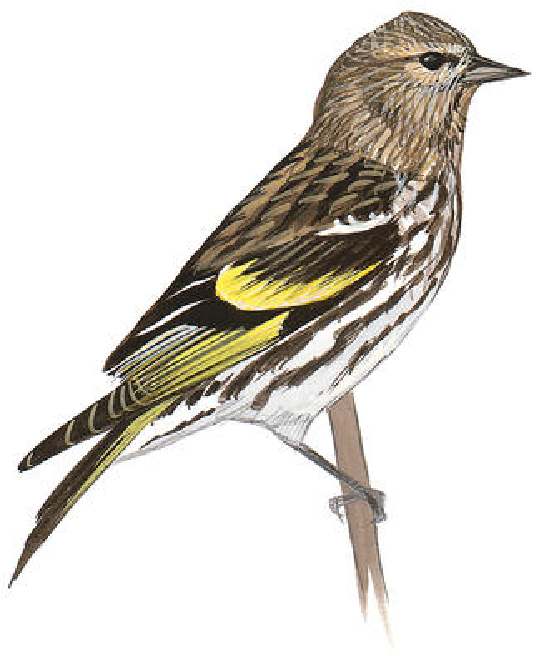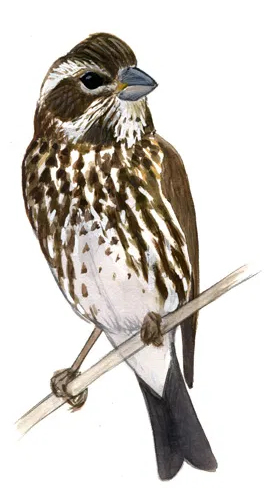Invaders from the North
In George R. R. Martin’s Game of Thrones, the people of The Kingdom of the North build a 700-foot-tall wall between them and the wild lands to their north. Their crucial goal: To keep out the White Walkers, mysterious creatures with a propensity to invade and wreak havoc. When the wall is finally breached and the Kingdom invaded, the residents’ response is all-out war.
Every few years, our northern latitudes are also swarmed by beings that more typically reside to our north. Our response, though, is quite different: We welcome the invaders happily. We even feed them.
Of course, our visitors aren’t icy creatures bent on our destruction. They’re birds, mostly finches, that are known as “irruptive species.” This means that they have the habit of sporadically and unpredictably heading south (“irrupting”) in vast waves from their homelands in the northern boreal forests and the Arctic.
Luckily for those of us who have set up feeders, or who merely keep an eye out for birds, this fall and winter are shaping up to be one of the most spectacular irruption years in recent times. Several northern finch species have already started making regular appearances at local feeders (and throughout the Northeast and, often, across much of the Lower Forty-eight). Others seem to be on their way as well.
Here’s a quick guide to what you might be seeing now or have the chance to see during the months to come, when birds give us glimpses of the natural world to lighten the dark days of winter.
PINE SISKINS

Most years, you won’t see a single one of these cousins to the familiar American Goldfinch. But when this heavily streaked smaller finch does choose to invade, it really invades. One day a few weeks ago we had at least thirty Siskins in and around our feeders at one time. (In the face of numbers like that, even House Sparrows give way!)
Pine Siskins don’t usually stray far from the boreal forests that are their home. This year, though, because of a comparative meager cone crop in the conifers they usually rely on for winter food they’ve headed south—not just to New York, but in big invasion years like this one, even as far as Mexico and Guatemala!
One interesting note: Unlike most small songbirds, which migrate at night, Siskins were always thought to be diurnal migrants. At the height of invasion waves this fall, though, they’d been seen flying by night as well. Perhaps there are simply too many of them to fit into the daytime flight paths!
PURPLE FINCH

A moderately close look is all it takes to tell a Pine Siskin from a Goldfinch, but identifying this visitor can be a trickier proposition. At a glance, Purple Finches look a lot like the House Finches that are among our most frequent feeder visitors. But Purple Finches are generally heftier, with fewer streaks, a richer purple color on the head and extending further down the breast (though both species’ colors can be variable), and a larger, straighter beak.

Females Purples can be easier to tell apart from their House counterparts. Along with heavier, darker streaking, they often have a bright white “eyebrow,” which makes for a clear ID.
Purple Finches have been regular at local feeders for several weeks now. Like the Siskins, they’re in search of food, but the causes are different. During nesting season, Purple Finches favor the Spruce Budworm, a moth whose caterpillar can defoliate and even kill large swathes of spruce and fir forests. In years of extensive outbreaks, like this one, the finches enjoy great breeding success.
Come fall and winter, with no Budworms available, the bumper crop of birds has to travel south to find food. Our feeders provide them with a welcome opportunity.
EVENING GROSBEAK

For us, a backyard visit by three of these relatives of the familiar Rose-breasted Grosbeak was one of the delights of the fall. They were the first my wife and I had seen south of Vermont, and even there these colorful birds are not a common sight.
Evening Grosbeaks are easily told from other feeder visitors by their size, their yellow-dominated or -tinged coloration (in a season when even goldfinches are drab) and their huge, yellow-ivory bills. They’ve moved south for the same reason as the Purple Finch: Spruce Budworm outbreaks led to an increased—and now hungry—population.
REDPOLLS and CROSSBILLS

There are two Redpoll and two Crossbill species, all of which are only rare winter visitors to our area. But in this remarkable invasion year, Common Redpolls have already been spotted in Croton Point Park, and both Red and White-winged Crossbill species not that far north of Westchester.
For many years, I thought that spring migration was the best time to pay full attention to birds. Chasing after the species returning to nest or simply passing through, getting to glimpse their variety and vivid colors after a long, bleak winter, was intoxicating.
I still love spring migration, still love the chase. But over the years I’ve learned that all times of year can be intoxicating for birders. Especially now—what I used to consider the “off-season”—when any day can bring a new, unexpected, and welcome invader from the north.
Copyright © 2020 by Joseph Wallace



